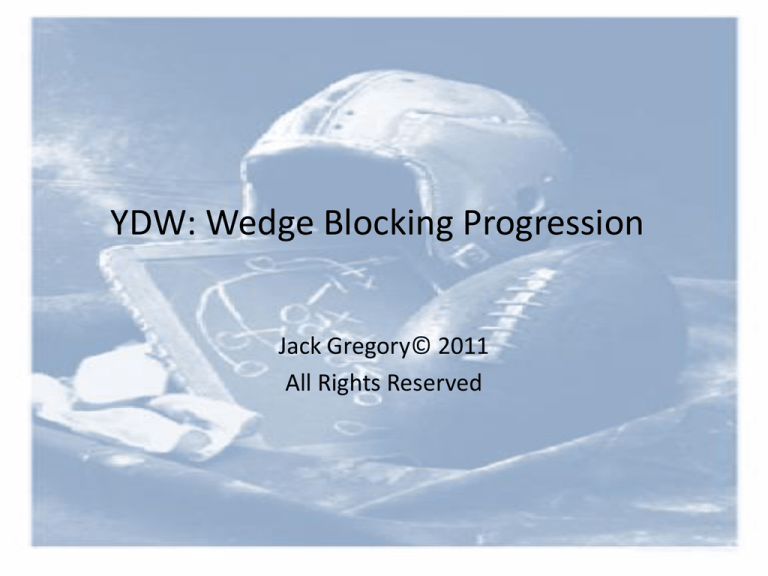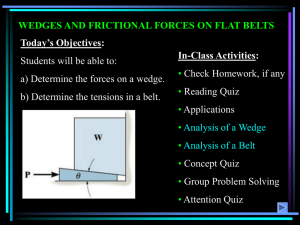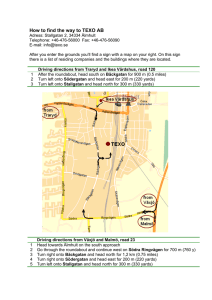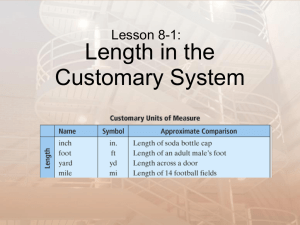
YDW: Wedge Blocking Progression
Jack Gregory© 2011
All Rights Reserved
Why Wedge Block?
• Wedge blocking is our basic scheme to attack the
interior (A gaps) and it is a blocking scheme that
requires every lineman in the wedge to work as a
team.
• It can, if properly taught and executed, be a
powerful blocking scheme that can force a
defense to respect the inside running game.
• Once the defense starts to stack the front to stop
the wedge, your offense will realize multiple
options of attack to the outside and in the
passing game.
Why Wedge Block? Cont’d
• At the younger age levels (ages five to eight) this
can be the single most effective and devastating
scheme against a young defense.
• At the older levels, defenses can adapt and
defend it - if it is a stand-alone scheme. However,
as a complimentary scheme, incorporated with
angle blocking schemes and perimeter schemes,
it becomes an essential component to a very
sound and effective blocking philosophy
combination that allows the offense to attack
every gap in a devastating manner.
What is Wedge Blocking?
• The Wedge is a very simple blocking scheme that can be built into a highly
successful series of plays.
• The line collapses on an apex blocker; the idea is to punch a hole into the
first level of the defense by having the blockers burst into the breach with
the runner in the middle of the wedge.
• Builds offensive line unity unlike any other scheme.
• Sets-up other plays in the series. When the defense sells out on the wedge
it opens up other plays.
• Allows optimal opportunity to interchange linemen.
• Can be used with a power or deception play. It is surprisingly deceptive.
• May be used with smaller or weaker players.
• Demoralizes to the other team.
• Always an offensive line favorite.
• Weaker backs can run in the wedge. The backs become interchangeable,
as the key component is the line.
Key Points of the Line Running Wedge:
• Center must fire out on a NT and drive up field.
• If there is no man over the center he aims for the end zone straight up the
field. He fires out and then takes a half step and lets the rest of the line
form and drive him up the field. (We don’t shift our wedge from odd to
even fronts – Center/PSG).
• The guards, out to the TEs, must step laterally to the inside (slide inside)
and get their inside shoulder into the near rib cage of the adjacent
lineman. They must also place their outside hand on the near shoulder
pad while the inside hand presses on the lower back. It might take the
tackle and ends two steps to get fit. They must attempt, at all costs, not to
make contact with any defender as they move down inside.
• As soon as they fit into the wedge they move up field. It should be one
instant movement. Slide and move up field as a unified body in two to
three steps.
• If the wedge slows or breaks apart, all the blockers must target a defender
and block that defender - like an upward burst of blockers with the runner
breaking through the explosion for the open field.
Why Keep the Center As the Focal
Point?
• READ DEFENSE: The main reason for keeping the Center as the main POA
is that otherwise, the center and guards would be required to identify an
ODD/EVEN front, and then identify who should be the apex of the wedge.
• THREE VARIATIONS: If you have the Center and both guards become the
apex of the wedge then you are essentially teaching three types of
wedges.
• Furthermore, if you use a guard as the apex, then you must be aware
that the back-side now must travel a further distance to form the wedge.
It is simpler and therefore preferable to teach a CENTER APEX WEDGE and
rep it until the line is really good at it.
• Finally if your line is recessed behind the CENTER and the GUARD is the
APEX of the wedge how does the CENTER FIT to either guard?
Challenges to the Wedge
• Submarining, Frogging, and/or Bearcrawling
Defenders
• Penetration
• Linemen Being Pulled from the Wedge
• Center not creating vertical space
• Wedge forming to slow
Wedge Progression #1
5 to 10 yards
Center Only
5 to 10 yards
C and G’s Only
5 to 10 yards
C, G’s and T’s Only
Form Wedge and Vertical Movement
5 to 10 yards
Full Line
Wedge Progression #2
5 to 10 yards
C and G’s Only
5 to 10 yards
C, G’s and T’s Only
5 to 10 yards
C, G’s and T’s Only
Mesh of Line and Vertical Movement
Wedge Progression #3
Knees Up – Get Vertical
Wedge Progression #4
15 Yards
5 to 10 Yards
Explode Drill
Adjustments
• Cut Wedge
– PSTE cuts the defender inside to reduce
penetration/pulling OT away from wedge
• Quick Wedge
– (DOWN-GO instead of DOWN-SET-GO)
• 5 Man Wedge/3 Man Cut Wedge
Questions/Comments?












